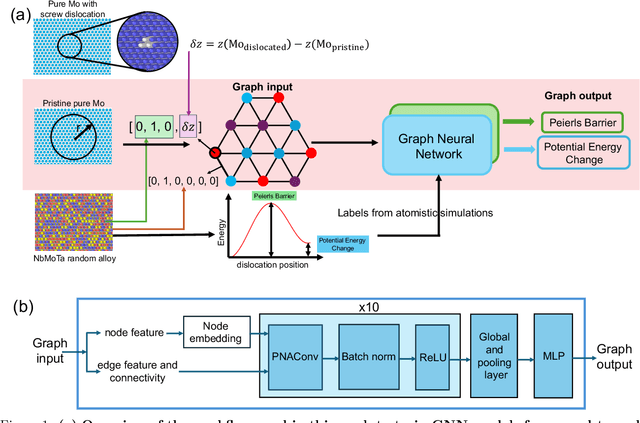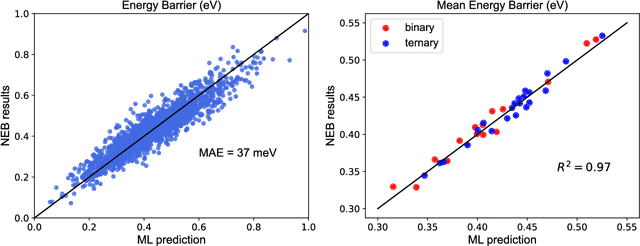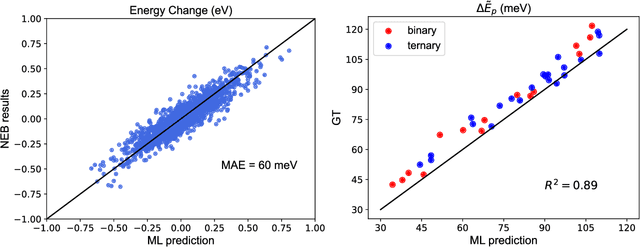Markus J. Buehler
Sparks: Multi-Agent Artificial Intelligence Model Discovers Protein Design Principles
Apr 26, 2025Abstract:Advances in artificial intelligence (AI) promise autonomous discovery, yet most systems still resurface knowledge latent in their training data. We present Sparks, a multi-modal multi-agent AI model that executes the entire discovery cycle that includes hypothesis generation, experiment design and iterative refinement to develop generalizable principles and a report without human intervention. Applied to protein science, Sparks uncovered two previously unknown phenomena: (i) a length-dependent mechanical crossover whereby beta-sheet-biased peptides surpass alpha-helical ones in unfolding force beyond ~80 residues, establishing a new design principle for peptide mechanics; and (ii) a chain-length/secondary-structure stability map revealing unexpectedly robust beta-sheet-rich architectures and a "frustration zone" of high variance in mixed alpha/beta folds. These findings emerged from fully self-directed reasoning cycles that combined generative sequence design, high-accuracy structure prediction and physics-aware property models, with paired generation-and-reflection agents enforcing self-correction and reproducibility. The key result is that Sparks can independently conduct rigorous scientific inquiry and identify previously unknown scientific principles.
Self-Organizing Graph Reasoning Evolves into a Critical State for Continuous Discovery Through Structural-Semantic Dynamics
Mar 24, 2025Abstract:We report fundamental insights into how agentic graph reasoning systems spontaneously evolve toward a critical state that sustains continuous semantic discovery. By rigorously analyzing structural (Von Neumann graph entropy) and semantic (embedding) entropy, we identify a subtle yet robust regime in which semantic entropy persistently dominates over structural entropy. This interplay is quantified by a dimensionless Critical Discovery Parameter that stabilizes at a small negative value, indicating a consistent excess of semantic entropy. Empirically, we observe a stable fraction (12%) of "surprising" edges, links between semantically distant concepts, providing evidence of long-range or cross-domain connections that drive continuous innovation. Concomitantly, the system exhibits scale-free and small-world topological features, alongside a negative cross-correlation between structural and semantic measures, reinforcing the analogy to self-organized criticality. These results establish clear parallels with critical phenomena in physical, biological, and cognitive complex systems, revealing an entropy-based principle governing adaptability and continuous innovation. Crucially, semantic richness emerges as the underlying driver of sustained exploration, despite not being explicitly used by the reasoning process. Our findings provide interdisciplinary insights and practical strategies for engineering intelligent systems with intrinsic capacities for long-term discovery and adaptation, and offer insights into how model training strategies can be developed that reinforce critical discovery.
Agentic Deep Graph Reasoning Yields Self-Organizing Knowledge Networks
Feb 18, 2025Abstract:We present an agentic, autonomous graph expansion framework that iteratively structures and refines knowledge in situ. Unlike conventional knowledge graph construction methods relying on static extraction or single-pass learning, our approach couples a reasoning-native large language model with a continually updated graph representation. At each step, the system actively generates new concepts and relationships, merges them into a global graph, and formulates subsequent prompts based on its evolving structure. Through this feedback-driven loop, the model organizes information into a scale-free network characterized by hub formation, stable modularity, and bridging nodes that link disparate knowledge clusters. Over hundreds of iterations, new nodes and edges continue to appear without saturating, while centrality measures and shortest path distributions evolve to yield increasingly distributed connectivity. Our analysis reveals emergent patterns, such as the rise of highly connected 'hub' concepts and the shifting influence of 'bridge' nodes, indicating that agentic, self-reinforcing graph construction can yield open-ended, coherent knowledge structures. Applied to materials design problems, we present compositional reasoning experiments by extracting node-specific and synergy-level principles to foster genuinely novel knowledge synthesis, yielding cross-domain ideas that transcend rote summarization and strengthen the framework's potential for open-ended scientific discovery. We discuss other applications in scientific discovery and outline future directions for enhancing scalability and interpretability.
In-situ graph reasoning and knowledge expansion using Graph-PReFLexOR
Jan 14, 2025Abstract:The pursuit of automated scientific discovery has fueled progress from symbolic logic to modern AI, forging new frontiers in reasoning and pattern recognition. Transformers function as potential systems, where every possible relationship remains latent potentiality until tasks impose constraints, akin to measurement. Yet, refining their sampling requires more than probabilistic selection: solutions must conform to specific structures or rules, ensuring consistency and the invocation of general principles. We present Graph-PReFLexOR (Graph-based Preference-based Recursive Language Modeling for Exploratory Optimization of Reasoning), a framework that combines graph reasoning with symbolic abstraction to dynamically expand domain knowledge. Inspired by reinforcement learning, Graph-PReFLexOR defines reasoning as a structured mapping, where tasks yield knowledge graphs, abstract patterns, and ultimately, final answers. Inspired by category theory, it encodes concepts as nodes and their relationships as edges, supporting hierarchical inference and adaptive learning through isomorphic representations. Demonstrations include hypothesis generation, materials design, and creative reasoning, such as discovering relationships between mythological concepts like 'thin places' with materials science. We propose a 'knowledge garden growth' strategy that integrates insights across domains, promoting interdisciplinary connections. Results with a 3-billion-parameter Graph-PReFLexOR model show superior reasoning depth and adaptability, underscoring the potential for transparent, multidisciplinary AI-driven discovery. It lays the groundwork for general autonomous reasoning solutions.
Graph-Aware Isomorphic Attention for Adaptive Dynamics in Transformers
Jan 07, 2025Abstract:We present an approach to modifying Transformer architectures by integrating graph-aware relational reasoning into the attention mechanism, merging concepts from graph neural networks and language modeling. Building on the inherent connection between attention and graph theory, we reformulate the Transformer's attention mechanism as a graph operation and propose Graph-Aware Isomorphic Attention. This method leverages advanced graph modeling strategies, including Graph Isomorphism Networks (GIN) and Principal Neighborhood Aggregation (PNA), to enrich the representation of relational structures. Our approach captures complex dependencies and generalizes across tasks, as evidenced by a reduced generalization gap and improved learning performance. Additionally, we expand the concept of graph-aware attention to introduce Sparse GIN-Attention, a fine-tuning approach that employs sparse GINs. By interpreting attention matrices as sparse adjacency graphs, this technique enhances the adaptability of pre-trained foundational models with minimal computational overhead, endowing them with graph-aware capabilities. Sparse GIN-Attention fine-tuning achieves improved training dynamics and better generalization compared to alternative methods like low-rank adaption (LoRA). We discuss latent graph-like structures within traditional attention mechanisms, offering a new lens through which Transformers can be understood. By evolving Transformers as hierarchical GIN models for relational reasoning. This perspective suggests profound implications for foundational model development, enabling the design of architectures that dynamically adapt to both local and global dependencies. Applications in bioinformatics, materials science, language modeling, and beyond could benefit from this synthesis of relational and sequential data modeling, setting the stage for interpretable and generalizable modeling strategies.
Learning the rules of peptide self-assembly through data mining with large language models
Nov 08, 2024



Abstract:Peptides are ubiquitous and important biologically derived molecules, that have been found to self-assemble to form a wide array of structures. Extensive research has explored the impacts of both internal chemical composition and external environmental stimuli on the self-assembly behaviour of these systems. However, there is yet to be a systematic study that gathers this rich literature data and collectively examines these experimental factors to provide a global picture of the fundamental rules that govern protein self-assembly behavior. In this work, we curate a peptide assembly database through a combination of manual processing by human experts and literature mining facilitated by a large language model. As a result, we collect more than 1,000 experimental data entries with information about peptide sequence, experimental conditions and corresponding self-assembly phases. Utilizing the collected data, ML models are trained and evaluated, demonstrating excellent accuracy (>80\%) and efficiency in peptide assembly phase classification. Moreover, we fine-tune our GPT model for peptide literature mining with the developed dataset, which exhibits markedly superior performance in extracting information from academic publications relative to the pre-trained model. We find that this workflow can substantially improve efficiency when exploring potential self-assembling peptide candidates, through guiding experimental work, while also deepening our understanding of the mechanisms governing peptide self-assembly. In doing so, novel structures can be accessed for a range of applications including sensing, catalysis and biomaterials.
Rapid and Automated Alloy Design with Graph Neural Network-Powered LLM-Driven Multi-Agent Systems
Oct 17, 2024



Abstract:A multi-agent AI model is used to automate the discovery of new metallic alloys, integrating multimodal data and external knowledge including insights from physics via atomistic simulations. Our multi-agent system features three key components: (a) a suite of LLMs responsible for tasks such as reasoning and planning, (b) a group of AI agents with distinct roles and expertise that dynamically collaborate, and (c) a newly developed graph neural network (GNN) model for rapid retrieval of key physical properties. A set of LLM-driven AI agents collaborate to automate the exploration of the vast design space of MPEAs, guided by predictions from the GNN. We focus on the NbMoTa family of body-centered cubic (bcc) alloys, modeled using an ML-based interatomic potential, and target two key properties: the Peierls barrier and solute/screw dislocation interaction energy. Our GNN model accurately predicts these atomic-scale properties, providing a faster alternative to costly brute-force calculations and reducing the computational burden on multi-agent systems for physics retrieval. This AI system revolutionizes materials discovery by reducing reliance on human expertise and overcoming the limitations of direct all-atom simulations. By synergizing the predictive power of GNNs with the dynamic collaboration of LLM-based agents, the system autonomously navigates vast alloy design spaces, identifying trends in atomic-scale material properties and predicting macro-scale mechanical strength, as demonstrated by several computational experiments. This approach accelerates the discovery of advanced alloys and holds promise for broader applications in other complex systems, marking a significant step forward in automated materials design.
PRefLexOR: Preference-based Recursive Language Modeling for Exploratory Optimization of Reasoning and Agentic Thinking
Oct 16, 2024



Abstract:PRefLexOR (Preference-based Recursive Language Modeling for Exploratory Optimization of Reasoning) combines preference optimization with concepts from Reinforcement Learning to enable models to self-teach through iterative reasoning improvements. We propose a recursive learning approach that engages the model in multi-step reasoning, revisiting, and refining intermediate steps before producing a final output in training and inference phases. Through multiple training stages, the model first learns to align its reasoning with accurate decision paths by optimizing the log odds between preferred and non-preferred responses. During this process, PRefLexOR builds a dynamic knowledge graph by generating questions from random text chunks and retrieval-augmentation to contextualize relevant details from the entire training corpus. In the second stage, preference optimization enhances model performance by using rejection sampling to fine-tune reasoning quality by continually producing in-situ training data while masking the reasoning steps. Recursive optimization within a thinking token framework introduces iterative feedback loops, where the model refines reasoning, achieving deeper coherence, consistency, and adaptability. Implemented in small language models with only 3 billion parameters, we should that even tiny models can iteratively teach themselves to reason with greater depth and reflectivity. Our implementation is straightforward and can be incorporated into any existing pretrained LLM. We focus our examples on applications in biological materials science and demonstrate the method in a variety of case studies that range from in-domain to cross-domain applications. Using reasoning strategies that include thinking and reflection modalities we build a multi-agent recursive self-improving inference approach to successively improve responses via repeated sampling in inference time.
SciAgents: Automating scientific discovery through multi-agent intelligent graph reasoning
Sep 09, 2024Abstract:A key challenge in artificial intelligence is the creation of systems capable of autonomously advancing scientific understanding by exploring novel domains, identifying complex patterns, and uncovering previously unseen connections in vast scientific data. In this work, we present SciAgents, an approach that leverages three core concepts: (1) the use of large-scale ontological knowledge graphs to organize and interconnect diverse scientific concepts, (2) a suite of large language models (LLMs) and data retrieval tools, and (3) multi-agent systems with in-situ learning capabilities. Applied to biologically inspired materials, SciAgents reveals hidden interdisciplinary relationships that were previously considered unrelated, achieving a scale, precision, and exploratory power that surpasses traditional human-driven research methods. The framework autonomously generates and refines research hypotheses, elucidating underlying mechanisms, design principles, and unexpected material properties. By integrating these capabilities in a modular fashion, the intelligent system yields material discoveries, critique and improve existing hypotheses, retrieve up-to-date data about existing research, and highlights their strengths and limitations. Our case studies demonstrate scalable capabilities to combine generative AI, ontological representations, and multi-agent modeling, harnessing a `swarm of intelligence' similar to biological systems. This provides new avenues for materials discovery and accelerates the development of advanced materials by unlocking Nature's design principles.
AtomAgents: Alloy design and discovery through physics-aware multi-modal multi-agent artificial intelligence
Jul 13, 2024Abstract:The design of alloys is a multi-scale problem that requires a holistic approach that involves retrieving relevant knowledge, applying advanced computational methods, conducting experimental validations, and analyzing the results, a process that is typically reserved for human experts. Machine learning (ML) can help accelerate this process, for instance, through the use of deep surrogate models that connect structural features to material properties, or vice versa. However, existing data-driven models often target specific material objectives, offering limited flexibility to integrate out-of-domain knowledge and cannot adapt to new, unforeseen challenges. Here, we overcome these limitations by leveraging the distinct capabilities of multiple AI agents that collaborate autonomously within a dynamic environment to solve complex materials design tasks. The proposed physics-aware generative AI platform, AtomAgents, synergizes the intelligence of large language models (LLM) the dynamic collaboration among AI agents with expertise in various domains, including knowledge retrieval, multi-modal data integration, physics-based simulations, and comprehensive results analysis across modalities that includes numerical data and images of physical simulation results. The concerted effort of the multi-agent system allows for addressing complex materials design problems, as demonstrated by examples that include autonomously designing metallic alloys with enhanced properties compared to their pure counterparts. Our results enable accurate prediction of key characteristics across alloys and highlight the crucial role of solid solution alloying to steer the development of advanced metallic alloys. Our framework enhances the efficiency of complex multi-objective design tasks and opens new avenues in fields such as biomedical materials engineering, renewable energy, and environmental sustainability.
 Add to Chrome
Add to Chrome Add to Firefox
Add to Firefox Add to Edge
Add to Edge